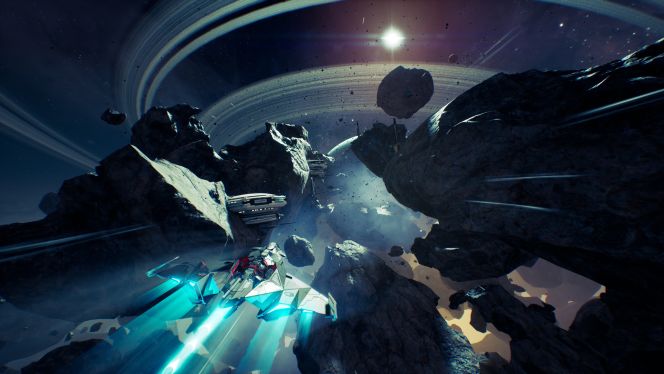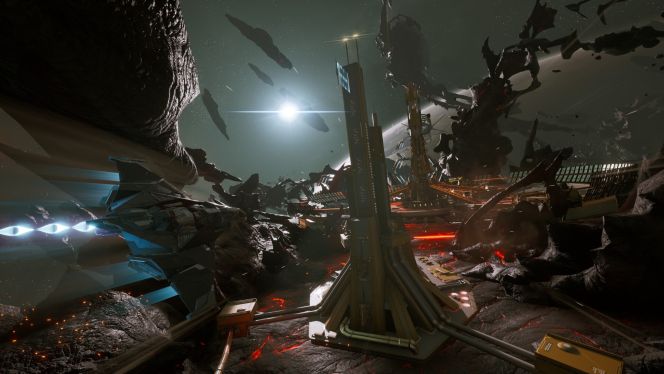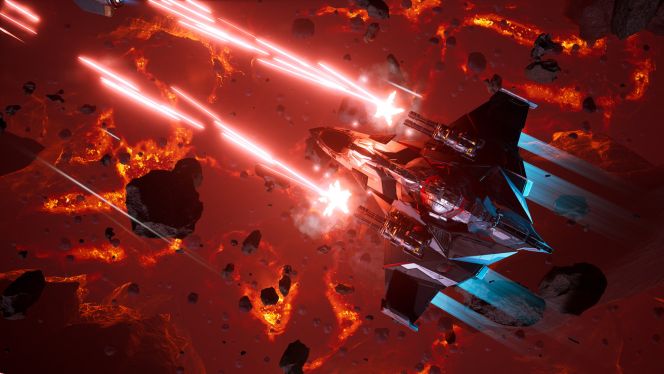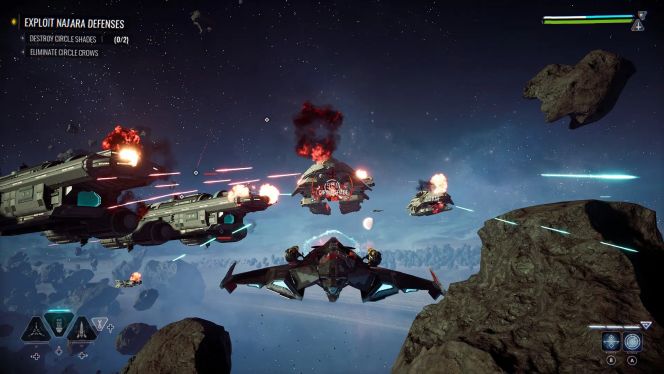REVIEW – Besides the space combat simulator element, there’s an open world to explore in this ambitious new sci-fi action game.
Chorus makes you wonder why there are not more games of this type. Apart from a couple of Star Wars titles, Wing Commander and the classic Star Fox, I can’t remember any genuinely notable single-player AAA 3D space shooters, and it’s hard to understand why this genre is so neglected. How odd that an open-world spaceship game where you just fly around killing people would seem refreshing, but that’s the case. Fortunately, the developers have done a good job with Chorus and have proven that there is still life in the genre.
“Space is the final frontier” (Star Trek)
Of course, “open-world” can be a bit of an exaggeration because Chorus doesn’t have a “world”, just endless space, clusters of asteroids and big metal buildings floating in the void. And there’s not much worth exploring without knowing where you’re going because, well, much of it is empty. Better to simply fly at maximum speed between missions, perhaps picking up an emergency beacon en route while taking in the scenery. Indeed, given the limited scope of the environment, Chorus is surprisingly colourful, with menacing planets and distant stars casting a glow on the rocks and debris from past wars.
Compared to all these great natural and man-made wonders, your own spaceship seems insignificant, but it is not just anyone who is in control. Nara, the pilot of the single-seat, triangular aircraft, has unique abilities that she intends to use to eradicate the genocidal cult known as the Circle, of which she was once a member and one of the most respected. After blowing up an entire planet at their behest, Nara had a bad feeling about this and is now helping the resistance.
Precise and fast control
Initially, you’ll need to use Nara’s super senses to find energy capsules or hunt down the occasional pirate with a machine gun. It’s a bit slow to start, but you need to get to grips with the controls. True, the gameplay experience is a bit strange at first, almost like an FPS. You use the right stick control to steer, accelerate and decelerate your plane, and the left stick control to “slalom” back and forth, rolling back and forth to dodge enemy shots. Once you get the hang of it, the controls are still precise, and you can fly through asteroids, for example, in no time at all. It helps to be able to turn the plane sharply or even come to a quick stop if you’re about to hit something.
I started to understand how precise this system could be when I won my first major battle against the Circle when I was fighting in defence of the “Enclave”, the main resistance headquarters in the early part of the game. This long tower structure surrounded by colossal metal rings is perfect for adrenaline-pumping space battles while looping around its protrusions to hunt down cult enemies. The fast gameplay and precise controls constantly encourage you to squeeze through tight spaces even while your energy shield is recharging, relying on your reflexes and fast machine as you gain the necessary routine for the more significant battles to come.
The Enclave section also introduces one of the game’s most revolutionary challenges: the enemy uses “psychic totems”. These spit-like missiles attach themselves to opposing ships and stations, taking control of the crew and forcing them to turn their weapons on you until you fire the parasitic object. This cruel trick is only made more devious when they latch onto the inside of allied ships, forcing you to fly in to take them out.
Yes, you read it right. The best thing about the design of the larger Chorus spaceships is that they are full of entrances and passageways leading to the central components. So if you have to fight one of the Circle’s most powerful specimens, like a Wraith, you have to take out the shield generators first, then fly into the exposed reactor to finish it off, then quickly fly out before the whole thing blows up.
May the rite be with you!
The gameplay of Chorus is gratifying when fighting in such a behemoth or when squads of buzzing fighters are charging at you to try and shake them off, only to get behind them as they try to take you down with a barrage of laser blasts. It’s got the feel of a good Star Wars battle, with jet fighters, the noise of laser blasts and almost constant radio chatter.
Of course, our lonely ship would be shot to pieces pretty quickly if Nara didn’t have her special skills up her sleeve: the “rituals” she acquires at a certain point in the story.
The Drift rite, for example, allows you to make sweeping turns while facing your target, while the Star rite will enable you to rush straight at enemies with impunity. The one move that allows you to teleport virtually directly behind an enemy in your vicinity feels almost like cheating, but it’s an essential time-saver in more heated battles. Juggling these and your three weapons – a gatling gun, laser and rockets (which can be upgraded along with defences) – is essential to effectively pierce armour and shields.
Disturbance in the Force
However, not everything in Chorus is so balanced or well-executed. The open-world structure may seem like a good idea at first, but it should have found a way to add variety to the gameplay. In some cases, this is delicate – missions, where you have to defend a larger allied ship, chase a target through an asteroid field, or slam into a tank-like ship with belligerent cannons, are exhilarating. But there’s also a lot of tedious ‘dead time’, especially in side missions such as collecting salvage or searching for ‘relics’. In contrast, the temple missions involve a lot of slow-flying through narrow corridors.
But the worst comes later in the game when encounters repeatedly replace traditional spaceship battles with more surreal entities. The most formidable enemies here come in the climaxes of the middle and final act, where you’re forced to put down the most confusing, bizarrely difficult and pointlessly long boss fights I’ve played in years. The final boss fight is staggeringly long and mind-numbing boring, a massive blunder on the developers’ part.
There are also a lot of minor frustrations, which usually stem from the fact that the game doesn’t show or tell us clearly what it wants from us. Often you rely on conversations between Nara and her ship’s AI to guide you, but the script is so full of sci-fi jargon that it can take a minute to interpret them – and in that time, you might get shot or lose the enemy you’re supposed to be tracking. On a couple of occasions, I’ve died instantly when a new enemy appeared because I was hovering right near their spawn point. It’s incredibly annoying in such cases that you have to replay the previous scene first, too.
It is a rather amateurish developer’s mistake that the dialogues are often repetitive, and it is annoying because they are not very interesting at first. In Chorus, the story is a very prominent element, even though it’s just a very average sci-fi story that helps move the events forward, say by having to rescue refugees or reunite families. However, on the larger scale, the end-of-the-world narrative is very flat, full of “faceless” (literally – that’s what they’re called) villains and lots of mystical mumbo-jumbo. Also, a story that takes itself too seriously, with not much humour or dialogue.
It’s like a B-movie
Still, even if this all seems a bit B-movie sci-fi, it’s worth noting that Chorus is not a vast AAA project (and is priced accordingly). Some major frustrations aside, we can forgive the developers for the game being a little unpolished, with sloppy, amateurish solutions in places, especially given that the core gameplay is as exciting as I’d hoped it would be. If we’re not going to see any more big-budget games from this genre, Chorus is at least a worthy attempt to fill that gap.
-BadSector-
Thanks to Magnew Ltd. for the PlayStation 5 code!
Pro:
+ Space war and combat is precise and enjoyable
+ Variety of weapons, targets, locations and opponents
+ Reasonably priced
Against:
– Terribly flat story, boring dialogue
– Annoying design choices
– Repetitive or confusing missions
Publisher: Deep Silver
Developer: Fishlabs
Genre: spaceship open-world action game
Release date: December 3, 2021
Chorus
Gameplay - 7.4
Graphics - 8.2
Story - 5.8
Music/sounds - 7.2
Ambience - 7.5
7.2
GOOD
Still, even if this all seems a bit B-movie sci-fi, it's worth noting that Chorus is not a vast AAA project (and is priced accordingly). Some major frustrations aside, we can forgive the developers for the game being a little unpolished, with sloppy, amateurish solutions in places, especially given that the core gameplay is as exciting as I'd hoped it would be. If we're not going to see any more big-budget games from this genre, Chorus is at least a worthy attempt to fill that gap.




















Leave a Reply